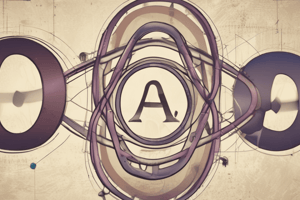Podcast
Questions and Answers
What defines the atomic number of an atom?
What defines the atomic number of an atom?
- Number of electrons
- Number of protons (correct)
- Number of neutrons
- Total number of subatomic particles
What is the mass number of an atom defined by?
What is the mass number of an atom defined by?
- Number of protons x Number of neutrons
- Number of protons - Number of electrons
- Number of protons + Number of neutrons (correct)
- Number of neutrons - Number of electrons
Which subatomic particle has a negative charge and essentially 0 atomic mass units?
Which subatomic particle has a negative charge and essentially 0 atomic mass units?
- Electron (correct)
- Proton
- Positron
- Neutron
What symbol is used to represent the atomic number of an element?
What symbol is used to represent the atomic number of an element?
What is the charge and location of a proton within an atom?
What is the charge and location of a proton within an atom?
What is the atomic number of an element?
What is the atomic number of an element?
What does the mass number represent for a single atom?
What does the mass number represent for a single atom?
What is atomic mass based on?
What is atomic mass based on?
What are atoms of different elements with the same atomic mass known as?
What are atoms of different elements with the same atomic mass known as?
What does atomic mass represent for an element?
What does atomic mass represent for an element?
What is the correct definition of the atomic number?
What is the correct definition of the atomic number?
Which statement accurately describes the mass number?
Which statement accurately describes the mass number?
How can the number of neutrons in an atom be determined?
How can the number of neutrons in an atom be determined?
Which factor determines an element's identity?
Which factor determines an element's identity?
How is the mass number calculated for an atom?
How is the mass number calculated for an atom?
Flashcards are hidden until you start studying
Study Notes
- Atoms have subatomic particles called electrons, protons, and neutrons.
- Electrons travel in orbitals outside the nucleus, have no charge, and a mass of approximately one atomic mass unit.
- Protons have a positive charge, are located in the nucleus, and have a mass of one atomic mass unit.
- Neutrons have no charge, are located in the nucleus, and have a mass of one atomic mass unit.
- The atomic number is the number of protons in an atom and can be found on the periodic table.
- The mass number is the sum of the protons and neutrons in an atom's nucleus and can vary for different isotopes of the same element.
- The atomic number and mass number can be used together to determine the number of neutrons in an atom.
- An element's identity is determined by its atomic number, which is the number of protons in its nucleus.
- Atoms of the same element with different numbers of neutrons are called isotopes and have different mass numbers.
- An atom can be represented by its element symbol, atomic number, and/or mass number.
- The mass number can be calculated as the sum of the atomic number and the number of neutrons in an atom.
- Knowing the atomic and mass numbers of an atom can help determine the number of neutrons in the atom.
Studying That Suits You
Use AI to generate personalized quizzes and flashcards to suit your learning preferences.




